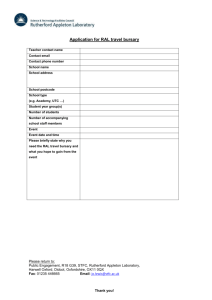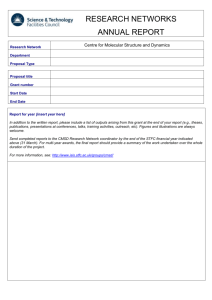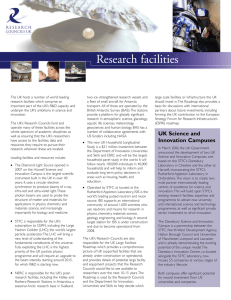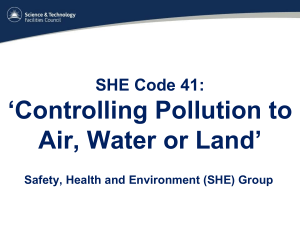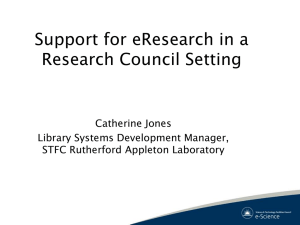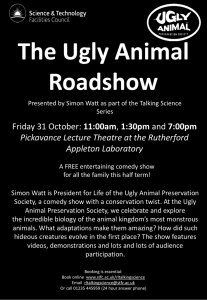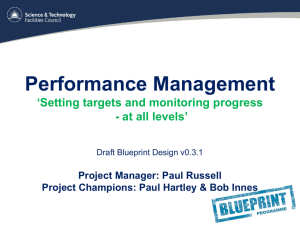Fascination Magazine - Science and Technology Facilities Council
advertisement
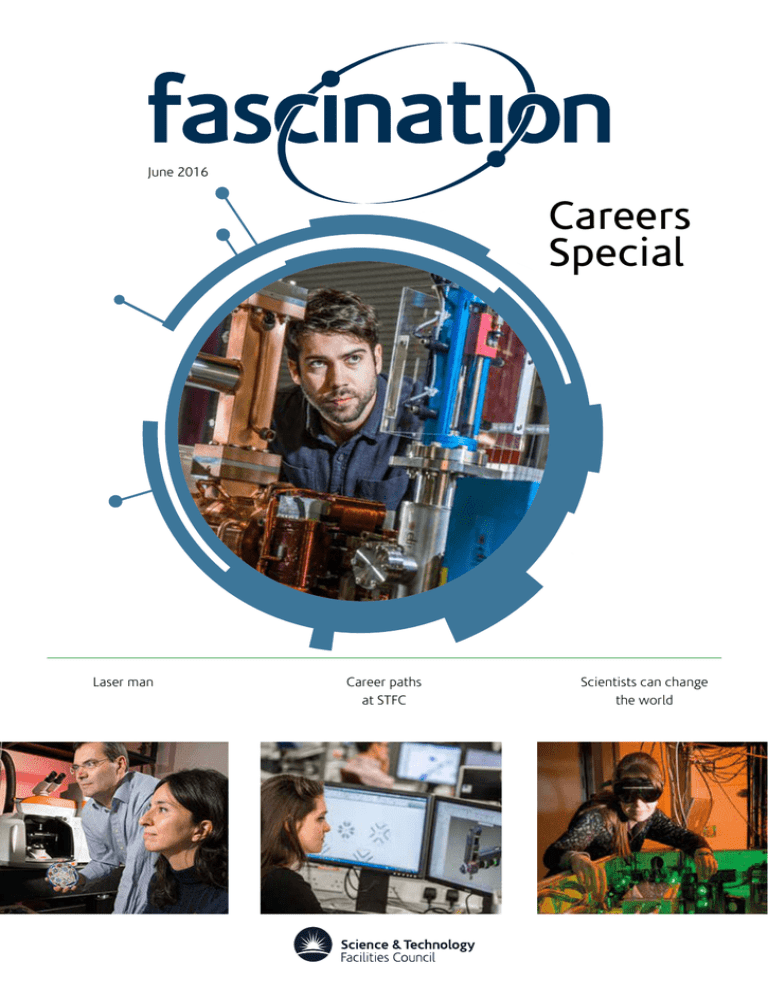
June 2016 Careers Special Laser man Career paths at STFC Scientists can change the world Welcome Contents In this special Fascination magazine careers supplement, we give you the lowdown on what it’s like to become a scientist, engineer or business support professional at STFC and how to get there. The work we do helps to shape societies, strengthen economies, build industries, create jobs and transform lives. But what’s the best thing about working in science? Some of our staff and friends from the science community tell us on page 4. Why science? pg. 4 - 6 There’s only one way to find out whether a career within the science and engineering world is for you – and that’s to try it out! Turn to page 14 to find out more about our work experience and student placements. Laser man pg. 7 - 9 Career paths at STFC pg. 10 - 12 Becoming a scientist or engineer pg. 13 Student placements and work experience pg. 14 - 16 Scientists can change the world pg. 17 - 19 4 Social media gurus, laser scientists, physicists, finance experts, electrical engineers, HR specialists… these are just some of the many different kinds of professionals who work together at STFC. Wherever you join us and whatever your role, we’ll offer the kind of work that will give you lifelong pride. At STFC, whether you’re a space scientist or a communications professional, your work will play a part in changing the world for the better. Turn to page 10 to learn more about STFC career paths. We hope you enjoy reading this special careers supplement and finding out more about the breadth of exciting career opportunities available at STFC. Best wishes, The Fascination editorial team 10 About Us Our scientific research seeks to understand the Universe from the largest astronomical scales to the tiniest constituents of matter. Providing access to and managing a range of world-class research facilities, the Science and Technology Facilities Council delivers fundamental insight and scientific breakthroughs in areas ranging from particle and nuclear physics to space, laser and materials science. Through our UK operations and our involvement in major international collaborations, we generate outcomes that shape societies, strengthen economies, build industries, create jobs and transform lives. Don’t miss an issue Fascination is STFC’s quarterly in-house magazine. To receive an electronic version straight into your inbox for free, please visit: www.stfc.ac.uk/fascination and subscribe. 14 Contact us Email: Fascination@stfc.ac.uk Write: Fascination editor, Office B89, STFC, Daresbury Laboratory, Daresbury, Cheshire, WA4 4AD Tweet: @STFC_Matters facebook: Science-and-technology-facilities-council LinkedIn: STFC 4 FEATURES 5 FEATURES Why science? We asked a host of our scientists, engineers, support staff and friends from the science community to tell us what inspired them to pursue a science career and why they love what they do at STFC. Dr Roberto Trotta STFC Public Engagement Fellow, author and theoretical cosmologist at Imperial College, London “Science is the best career there is. It’s intellectually stimulating, different every day and it will allow you to contribute to one of humankind’s greatest cultural quests.” Dan Matselyukh Artemis Laboratory Experimental Scientist (placement student) Paul Eccleston Chief Engineer, RAL Space “Apart from continuously challenging you with everchanging problems, science attracts the brightest minds from all over the globe – producing an amazing multicultural environment that’s a pleasure to work in.” “I like working at STFC because of the interesting things we’re doing, how high-profile it is and the fact that it is absolutely cutting-edge. Nobody else in the world is doing the same stuff as we are. We’re having to push the boundaries every time.” Steve Griffiths Electrical Engineering Group Leader, STFC Dr Ceri Brenner Application Development Scientist for High Power Lasers at STFC “It’s extremely inspiring to see and understand the potential impact of the work you’re involved in. Take the prototype accelerator EMMA at Daresbury Laboratory, for example. My team was responsible for all the electrical engineering and the potential impact was to improve cancer treatments. A lot of the work we do can have a massive, long-term impact on people’s daily lives.” “My role as an application development physicist enables me to make a difference to our knowledge of the world and is contributing to big societal challenges like nuclear waste management, future energy sources and cancer treatment technology. I love the variation, too; I’m a project manager and team leader, an expert in using the most powerful lasers in the world to generate extreme states of matter, an innovator and communicator. I travel the world working on translational physics research, playing my part in developing technology that inspires me.” Professor Phil Manning Palaeontologist, Professor of Natural History and Director of the Interdisciplinary Centre for Ancient Life at the University of Manchester “My career has provided me with a wealth of experience in people, places and ideas that continues to grow day after day. No day is the same when you’re pushing the frontiers of science.” Dr Nathalie Pettorelli Co-founder of Soapbox Science Professor Pavel Matousek STFC Senior Fellow “Science allows me to express myself and be creative in my work; to explore the world, meet incredible people and broaden my horizons; to feel that what I do matters. It’s not the topic that got me hooked on science, it’s the lifestyle!” “As you push the boundaries of technology and make new discoveries, the end goal always changes. This is the nice thing about science... I am very excited about what I do and driven to answer questions in front of me, unravel complex problems and deliver something useful to society.” 6 FEATURES 7 FEATURES Laser man Kamile Zlatkute Sandwich Placement Student in Digital Communications at STFC “Being so close to scientists who are involved in lifechanging discoveries is what keeps me inspired. I get to see how beautiful the process of science is – it takes a certain kind of imagination and courage to go beyond limitations and solve some of the world’s biggest mysteries!” Marion O’Sullivan Scientific Computing Impact Manager at STFC “Although I’m not a scientist, I find science exhilarating and I seem to learn something new every day. STFC funds some of the sharpest minds on the planet and these scientists create the tools that can save lives, fuel the economy and make our world a better place in which to live. They continually amaze and inspire me.” Meet Pavel Matousek – the inspiring man who uses laser technology to change the world Dr Deepa Angal-Kalinin Accelerator Physics Group Leader, ASTeC, STFC Dr Claire Devereux Scientific Computing Project Leader, STFC “The work we do has the potential for massive impact. It gives you challenge and support, opportunities to specialise and develop your career and work with world leading scientists and engineers. Why would you not want to work here?” “Working at STFC is very exciting. Everyone who works here does it because they love the variety of work and the challenges. You’re always doing something new, working in new areas and pushing the frontiers. If you’re in the UK, STFC is one of the best places to stay ahead of the field.” Professor Pavel Matousek has an intriguing story to tell. Back in 2004 he and his collaborators at STFC’s Central Laser Facility stumbled across a technique for analysing the chemical make-up of materials. Four years later Pavel co-founded a company called Cobalt Light Systems to exploit applications of the technique, known as Spatially Offset Raman Spectroscopy (SORS), for noble purposes. Cobalt has won a Queen’s Award for Enterprise and its innovative technologies can be found on pharmaceutical production lines and in airports around the world. And, SORS has potential in even more lifesaving applications. Pavel, what first got you interested in physics? I became fascinated by the stars and Universe while growing up in the Czech Republic. I joined an astronomy society at secondary school and it became clear I wanted to study physics. I got very interested in laser physics during my MSc at the Czech Technical University in Prague. It is a very dynamic field. When did you arrive at Rutherford Appleton Laboratory (RAL)? I joined as a research associate in 1991, and went on to complete my PhD in ultra-fast Raman Spectroscopy at RAL, awarded by the Czech Technical University. So what is Raman Spectroscopy? It is a technique that involves shining a laser beam at the surface of a material, and then observing the colour of light scattered from the point of illumination. This typically provides information about the chemical composition of the material’s surface. C.V. Raman observed the effect in 1928 and subsequently won a Nobel Prize. 8 FEATURES You pioneered a technique called Spatially Offset Raman Spectroscopy (SORS): what is it and how does it differ from normal Raman Spectroscopy? Cobalt Light Systems is perhaps best known for its airport security scanners. Can you describe how these work and their impact to passenger travel? SORS is a technique that we stumbled across in the Ultrafast Spectroscopy Laboratory (ULTRA) by chance. We had assumed that photons could only be detected at the illumination point but we were wrong. Some photons migrate sideways through the material then emerge adjacent to the illumination point. As these photons have interacted with molecules deeper inside the medium, they provide information about internal chemical make-up: SORS probes deeper into the material. And the further you move from the illumination point, the deeper you see into the medium. The process involves large photon migration distances, often extending to several centimetres or more. This came as a big surprise. Security scanners represent the second generation of technology developed by Cobalt. To date there are around 400 operational units in 70 airports across Europe and Asia. They are used to scan traveller essentials, such as medicines or baby milk, and compare their chemical make-up to a database of potentially explosive substances. Suspicious substances are automatically identified and flagged. For example, the technology avoids passengers having to drink liquids (eg baby milk) in front of security officers to prove they are not dangerous, which is clearly safer and more hygienic. It has also contributed to new legislation, and is expected to lead to a relaxation of the complete ban of taking liquids on board a plane in the future. SORS involves probing at one location and detecting at another. Our minds, and those of others, were constrained by our perception of how the Raman Spectroscopy process worked but once we made this serendipitous discovery, we quickly realised it had potential major applications. The scanners are currently the size of a microwave oven but right now we are launching a SORS handheld device. This should have further applications for first responder teams called to spillages of unknown substances and fire fighters attending chemical fires. What kind of applications does it have? How did STFC help with this process? We immediately realised SORS could determine the chemical make-up of substances by non-destructive means. This could have applications in bio-medicine, chemistry, security, forensics, heritage, and beyond. But we first focused on pharmaceuticals, and developed novel ways for analysing the chemical make-up of manufactured drugs. My story illustrates the national and international importance of STFC. If its determination to deliver impact on science was absent, the chain from a fundamental discovery to Cobalt Light Systems’ product would have been broken. STFC responded appropriately at every stage. And this is just one example of how STFC contributes to the UK’s knowhow economy. The range of potential applications for SORS is staggering. We swiftly filed eight patents, which became the basis of our company Cobalt Light Systems. What are you working on currently? I’m focused on developing novel non-invasive medical screening techniques, including diagnosing bone disease such as osteoporosis (jointly with STFC’s Prof Tony Parker and University College London’s Prof Allen Goodship), and I’m working with Professor Nicolas Stone University of Exeter on noninvasive breast cancer screening. 9 FEATURES SORS art Application Credit: Professor Pavel Matousek In addition, I’m collaborating with Consiglio Nazionale delle Ricerche in Italy to apply the SORS technology to objects of art on microscales. For example, we can scan different layers of paint to determine compositional information essential in restoration and preservation of artefacts. How will the medical applications benefit patients? Patient benefit could be enormous. Current diagnosis techniques for osteoporosis are around 60-70% accurate as they sense only mineral content. SORS on the other hand has a high specificity for mineral and collagen content – both of which determine bone strength – and so holds considerable promise for providing improved diagnostic accuracy. SORS could also be used to classify breast or prostate tumours as malignant or benign without needle biopsy. This would reduce patient stress and save medical provider costs. However, medical problems are challenging as the human body is complex and variable. These applications are probably still seven-ten years away. Why do you do this research? This is where my passion and interest lies – I’m very excited about what I do. As you push the boundaries of technology and make new discoveries, the end goal always changes. This is the nice thing about science. 10 FEATURES Career paths at STFC Technology and computing jobs With some of the most remarkable scientific facilities in the world, we are contributing to some of the most exciting and challenging research projects happening right now, and you can be a part of it. What kind of jobs are available at STFC? Science jobs Engineering jobs Exploring the unknown. Tackling tough problems. Advancing knowledge. The research we undertake and support is ambitious in scope and far-reaching in its impact. We employ engineers across many different disciplines, including electrical, electronics, mechanical and across operations, design and build and project management, from instrumentation to major structures. The calibre and expertise of our staff, and our project and quality management expertise, enables us to deliver unique and advanced high performance engineering projects. As a scientist, (chemist, physicist or biologist) at STFC, you tackle the pressing questions in big science – using facilities that stand comparison with any in the world, in collaboration with the very highestcalibre of engineers and technologists. Our engineers are here to provide the tools to push the boundaries of science – and to explore ways to translate new technologies into practical applications. Many of our projects involve collaboration with universities, industry or other partners in the UK and worldwide. There are regularly opportunities to travel and learn abroad – and to attend conferences and events. Join us as an engineer and you could play a key role in building and running prestige facilities, such as our world-leading particle accelerator and lasers. You could be devising cutting edge solutions in areas like materials science, space technology and ultra-fast supercomputing. You’re given the space and resources to run research projects the right way- within a like-minded community of experts. The discoveries you make won’t just expand the world’s understanding of your discipline, they could translate directly into real work applications that change lives. You may get to create cutting edge instrumentation and technologies that make ground-breaking research possible. Your expertise could even inspire new products and equipment that change lives in the UK and around the world. Whether you are beginning or furthering your career, you will be in the right place to test your skills and build your technical know-how on complex, high profile projects. There are also opportunities to develop as a manager and leader. 11 Technology underpins our programmes, providing our researchers with a real breadth of expertise and enabling them to tackle challenges that would otherwise be beyond reach. Our technologies are world-class. The expertise of our people encompasses areas such as magnet and materials technology, cryogenics, energy technologies, electronics, detector design and installation, microelectronics and nanotechnology. In 1964, the Rutherford Appleton Laboratory opened the UK’s first purpose-built computer laboratory to house one of the world’s first supercomputers. In the same decade our team started a revolution in computer graphics and animation that led to rise of CGI. Over fifty years on, our organisation remains among the country’s leading centres of excellence in computing. We run some of the country’s most FEATURES powerful supercomputers and collectively our team have unparalleled knowledge in the field. This expertise is central to the design and delivery of much of what we do, especially given the vast amounts of data collected in our experiments and projects. Researchers and businesses from all over the world also turn to our computing power and know-how. Working in a computing role, you’ll become part of a team that is working with the very latest technologies – and driving advances in both hardware and software that have genuine realworld applications. FEATURES Professional and business support jobs The amazing work we do in the science and engineering fields wouldn’t be possible without the contribution of the talented people who keep our projects and organisation running smoothly. You don’t have to have any science qualifications to work with us in our professional support roles – just an enthusiasm for what we do is enough. We regularly recruit into roles such as project management, finance, administration, HR and communications, business development and programme management. All of these roles make a huge contribution to what we are able to achieve. 12 13 FEATURES Becoming a scientist or engineer There are a number of ways you can get the skills you need to become an STFC scientist or engineer – whether you are a school leaver, doing your A-levels or looking for a career change. Opportunities for… STFC opportunity STFC location Qualifications When do we recruit? Four-year Engineering Apprenticeship Harwell, Daresbury, Edinburgh BTEC NVQ Level 3 HNDor HNC January to March Two-year Computing Apprenticeship Harwell Part one of a foundation degree with the option to convert to a BSc with a further two years of study Ongoing Vacation student placement Harwell, Daresbury, Edinburgh 8-12 weeks paid work experience before or during your degree March to May A year in industry (organised through the Year in Industry Scheme) Harwell, Daresbury, Edinburgh A paid year of work experience in engineering or science Ongoing Sandwich year placement - usually year three of a fouryear degree Harwell, Daresbury, Edinburgh A paid year of work experience in engineering or science September - December School leavers Pre-university people or undergraduates If you work with us as a student for up to a year, you can earn the opportunity to be sponsored through the rest of your degree. Graduates Graduate scheme for graduates in computing, science and engineering Harwell, Daresbury, Edinburgh To find out more about these pathways, please visit www.stfc.ac.uk/isis Graduates are supported to achieve chartership with their professional institution Mainly October December but ongoing until all vacancies are filled 14 FEATURES 15 FEATURES Student placements and work experience You don’t have to wait until you graduate, or even until you leave school, to experience working at STFC. We have a variety of opportunities for both school students and undergraduates. Engineering work experience student at RAL Credit: STFC Whilst working at STFC on your placement or work experience, you will gain on-the-job work experience, working on real projects alongside expert scientists and engineers. By joining us on a placement, undergraduates could also earn the opportunity to be sponsored through the rest of their degree – before returning to us as a graduate. Work experience placements STFC offers one or two week work experience opportunities over the summer for school students in Years 10-13 at our National Laboratories: Daresbury Laboratory (DL) in Cheshire, Rutherford Appleton Laboratory (RAL) in Oxfordshire and the UK Astronomy Technology Centre (UKATC) in Edinburgh. It is a great way to find out what it is like to work at one of Europe’s largest research organisations, supporting scientists and engineers with their research. Work experience students at RAL Space programming a remote exploration vehicle Credit:STFC Year in industry Vacation student scheme The Year in Industry is an educational charity specialising in pre-university placements for students in science, engineering, IT and business. Students undertake 10-12 month-long projects, under the supervision of experts in the field, which might involve designing, testing and commissioning new equipment, systems or software. The Year in Industry runs a business awareness course, designed to teach professional skills. The scheme appoints mentors to ensure students get the most out of their placement. Each summer we have opportunities for undergraduate students to gain practical work experience with us, whilst earning a generous salary. Students tend to work between 4 -12 weeks at the RAL, DL, UKATC or the STFC Headquarters in Swindon on projects relevant to their degree under the supervision of experts in their chosen field. They might even be selected as one of our sponsored students and receive a payment of up to £6,000 per annum for the rest of their course. Karl Richardson, industry studentship states: “As a result of working with highly skilled colleagues and undertaking many varied tasks, I have developed valuable new skills. I now have more confidence in my ability to communicate effectively with other team members, and my listening skills have also greatly developed.” Sandwich student We love to engage with undergraduates. Each year we employ up to 45 sandwich students, giving students the opportunity to use and develop the skills they’ve acquired at university within a working environment during a year-long placement. Along the way students learn new skills to help further their studies. Sandwich student Milo Barraclough states: “I wasn’t sure what I wanted to use my degree to do and I thought the sandwich placements programme would be a great way to explore my options. Working in the labs and target areas with real scientists has been incredible, while the highlight of my placement has been designing and building a project that actually got used in an experiment. I like working here because I’m not just a student, I feel like I’m part of the team.” 17 FEATURES Scientists can change the world What do you want to be when you grow up? It’s a question that everyone dreads being asked at some point. These days we are faced with so much choice, so many different possible career paths, that it can feel overwhelming to decide what you want to accomplish in your career. If – when you think about it – you want to change the world; then you may wish to consider a career in science. Science influences almost every aspect of our lives. Here are some areas in which science has a very profound impact on the world. Medicine www.stfccareers.co.uk/careers/students No area of science has impacted human lives quite like medicine. In-depth understanding of the human body and how it interacts with its environment helps us to live longer than ever before. From vaccines, prosthetic limbs, organ transplants, cold medicines, antibiotics and plasters, modern medicine has lengthened and improved the quality of our lives, and continues to do so. Cancer: Engineers at STFC’s Cockcroft Institute are developing proton imaging technology that could provide more accurate cancer treatments. Radiotherapy with protons is important in some cancer treatments, particularly in children, as its greater treatment accuracy can reduce side effects. Anthrax could be an unexpected tool in the fight against cancer. The bacterium behind anthrax has been shown by scientists to be a possible solution for delivering drugs for a specific form of gene therapy. The novel approach could also have anti-viral and food security applications. Fertility: In winter months, the Eastern Wood Frog in North America survives being frozen to temperatures as low as -8°C for weeks. In spring, the frog thaws out and happily hops off. Scientists are trying to mimic the frog’s freezing process to improve the success rate of freeze storage techniques used in fertility treatments. FEATURES 18 Satellite technology: IPF Africa is a private company that helps African farmers monitor crops by World population could reach nine billion by providing access to European Space Agency (ESA) 2030 – that’s a lot of mouths to feed. Farming and satellite technology. Farmers use their smartphone/ agriculture must become more efficient to satiate tablets to record the precise location and cause of our rapidly growing collective appetite. crop damage while working the land. By enabling Robots: Robot technology designed for use on Mars farmers to record geo-referenced observations, the could help improve crop yields on Earth. A system technology allows them to target crop treatments developed originally to explore Mars has been on specific areas. This saves money and reduces transformed into an agricultural monitoring device the negative environmental impact of unnecessary for testing the quality of soil. The device, which is practices; such as spraying an entire area with a crop based on technology developed by STFC’s RAL Space, protection chemical. consists of a mobile rover platform with a robotic arm that carries a soil sensing instrument. It has the potential to reduce the environmental impact of farming. Agriculture 19 FEATURES Energy Transport One of the biggest challenges facing society is how we will meet our ever-increasing energy needs. Scientists are working hard to develop feasible renewable energy sources, while also trying to make technology more energy efficient. We do love to get around don’t we! Cars, trains, boats, planes – they all need fuel. But scientists are trying to make them more efficient. Graphene: A 2D carbon crystal, graphene is only one atom thick. It is a million times thinner than a piece of paper, and yet it’s stronger than steel and conducts electricity better than copper. At the same time it is flexible and stretchy, and can be rolled up into carbon nanotubes. Science and industry alike are very excited about its potential. Bound to hydrogen, graphene can be used to produces graphane: a material that has the potential to be a novel method for hydrogen storage, which could be key to the wider use of hydrogen as an energy source. Renewable energy: Scientists have recently overcome the challenge of breaking down raw biomass without the need for chemical pretreatment, and have produced record amounts of liquid hydrocarbon fuel as a result. The University of Manchester used STFC’s ISIS Neutron and Muon Source – often described as a ‘super-microscope’ to study the biomass and catalyst at the molecular level in order to produce useful fuel. Car batteries: Researchers from the UK and US have made a major breakthrough in understanding a battery material that could shake up the market for electric vehicles. Using a super-powerful electron microscope called SuperSTEM at STFC Daresbury Laboratory, Cheshire that can pinpoint single atoms a million times smaller than a human hair, researchers have identified the structure of lithium and manganese-rich transition metal oxides. These materials can potentially be used to make batteries with capacities double that of the most commonly used lithium-ion batteries. Hydrogen car: Private company River Simple has developed a hydrogen car, which has zero emissions at tailpipe. Engineers at the company aim to systematically pursue the elimination of the environmental impact of personal transportation. Find out more at www.stfccareers.co.uk/careers/students Science and Technology Facilities Council Polaris House, North Star House, Swindon SN2 1SZ, United Kingdom
